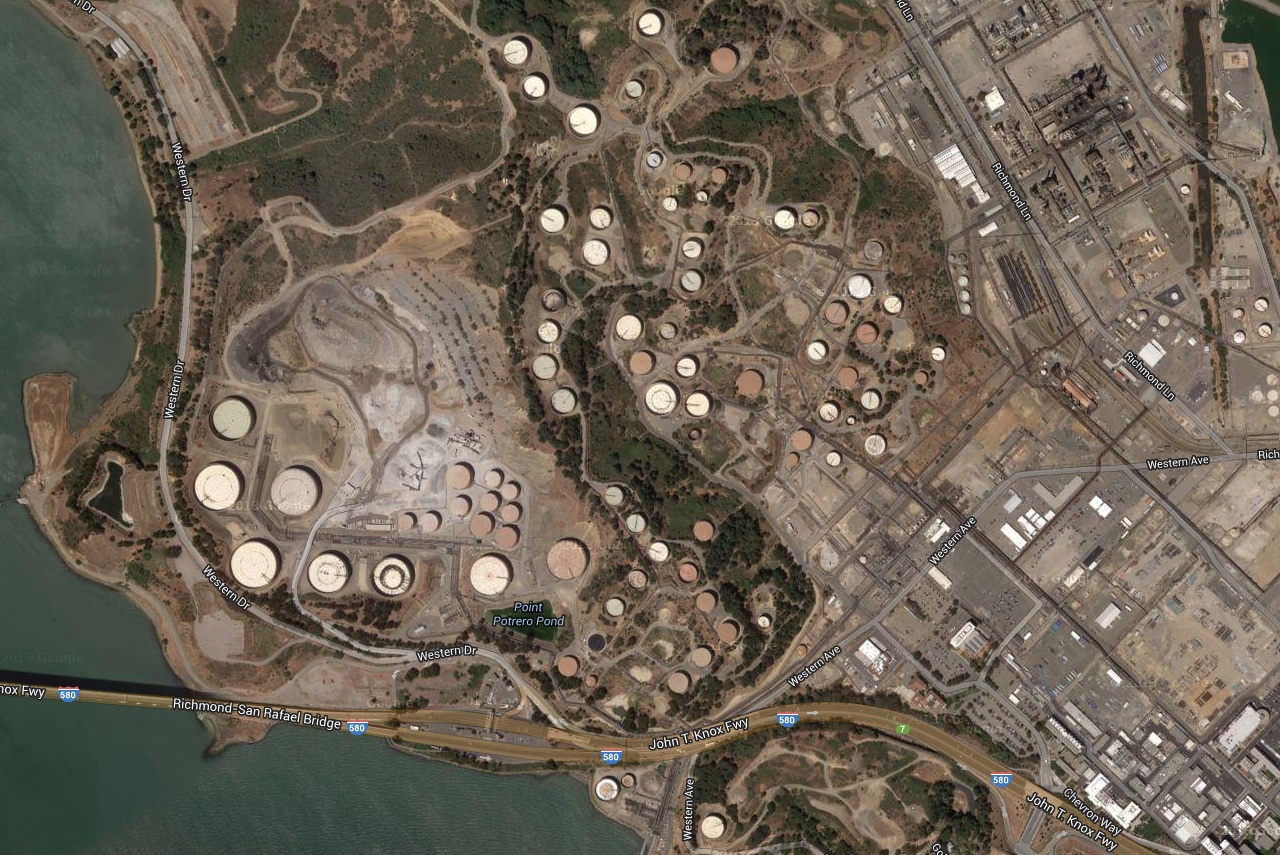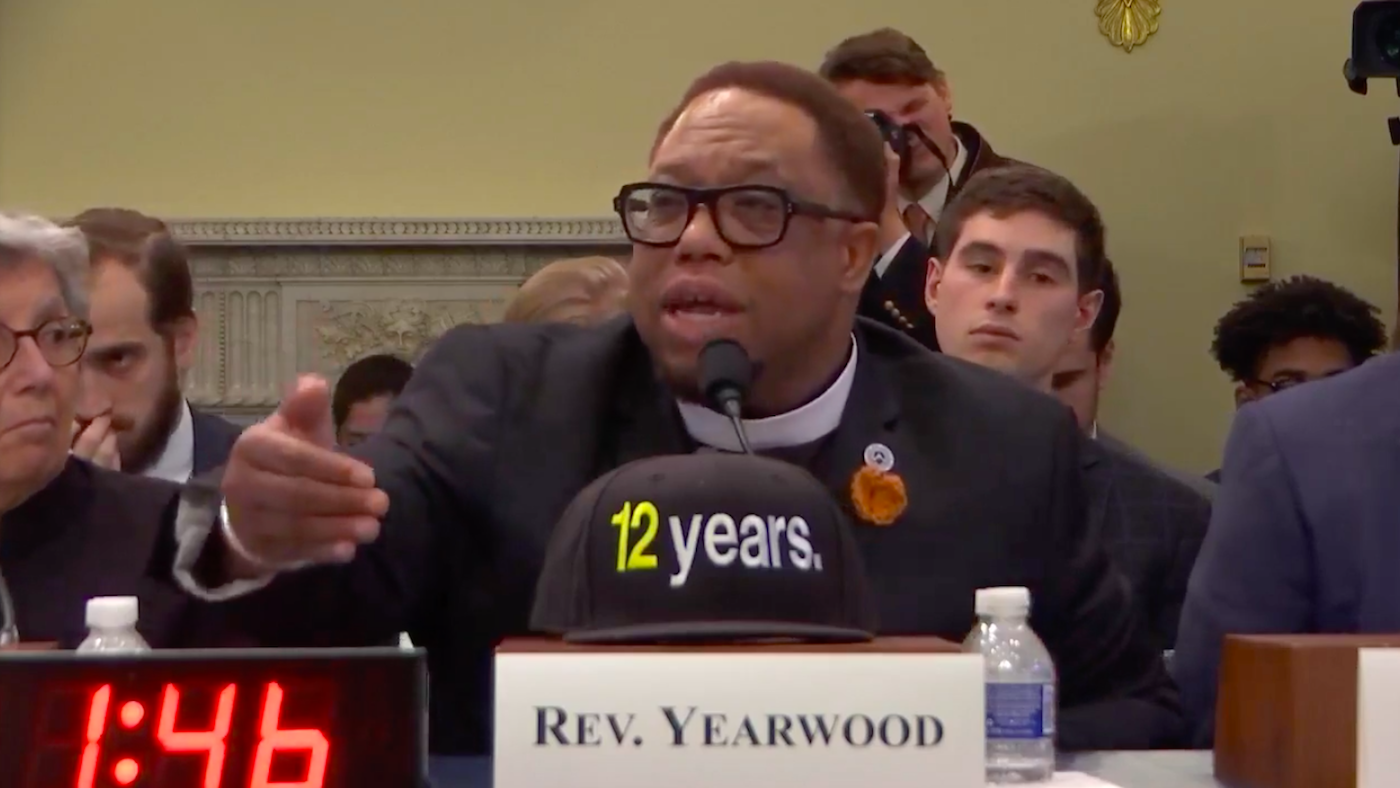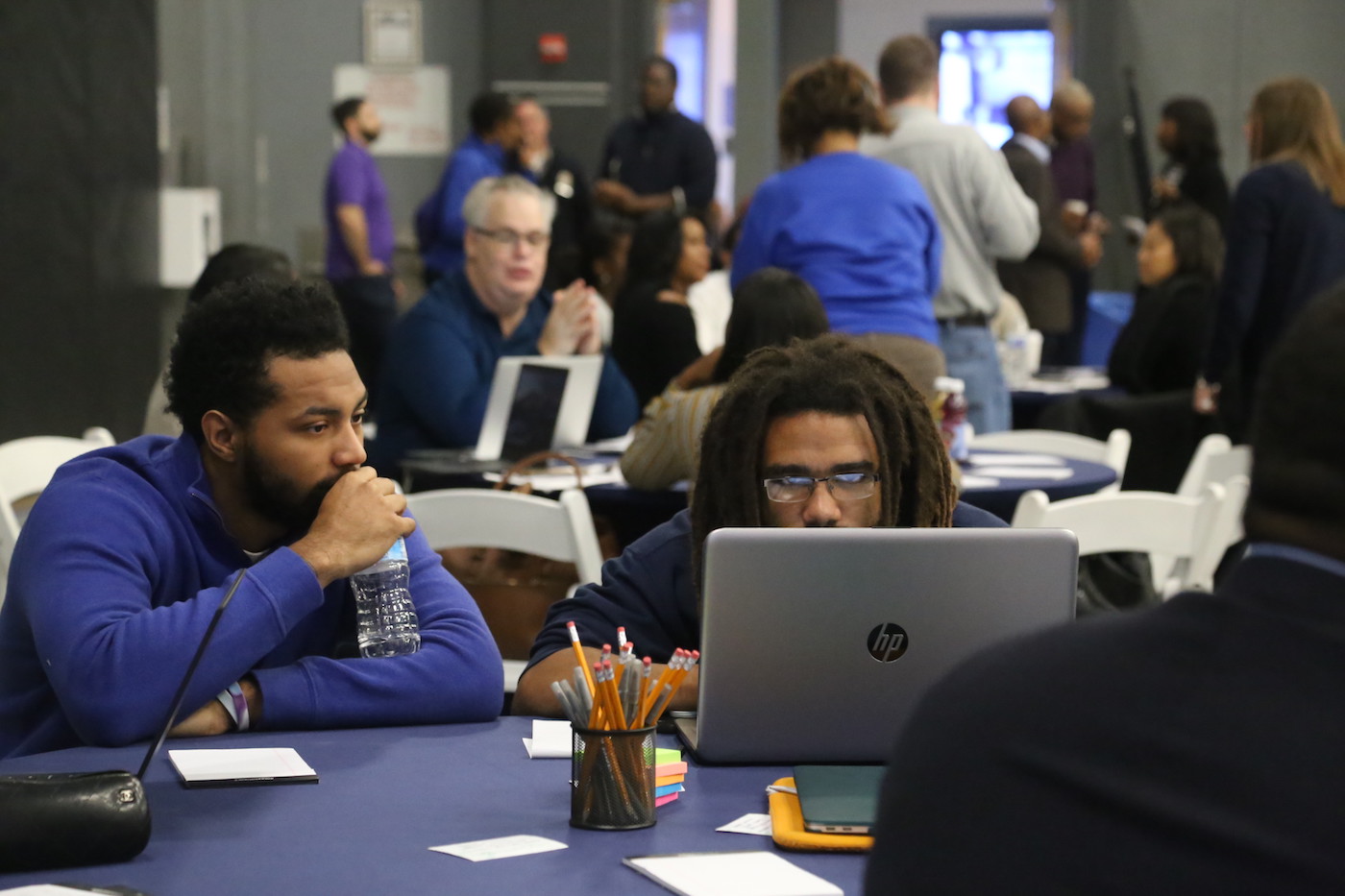On a chilly Saturday morning, a large group of mostly black and brown teens and college students streamed into a New York University gymnasium — not to exercise or play basketball but to discuss their communities’ energy challenges.
Clutching computer bags and business card holders, extra large sticky pads of paper and marker sets, the teens filed into the makeshift workspaces. Groups of participants huddled around conference tables swapping names and hometowns. Many had traveled across the country to be a part of the first hackathon hosted by the American Association of Blacks in Energy. The strategy session and competition focused specifically on energy issues that concern African-American communities.
Whiteboards across the gymnasium denoted topics to be hacked: achieving energy efficiency through shared energy technology, improving low-income community access to energy efficiency programs, energy and transportation-mobilization, etc. The students were joined by a handful of adults — renewable energy experts and fossil fuel execs — to brainstorm ways to “disrupt” the energy industry.
Black communities have a lot at stake when it comes to energy efficiency and innovation. On average, low-income neighborhoods and communities of color have lower quality housing stock, which tends to be more energy inefficient, driving up heating and cooling costs. In a 2016 report by the American Council for an Energy-Efficient Economy, researchers looked at median “energy burden” — defined as the percentage of gross income that a household spends on energy costs — in cities across the country. They found that the fraction of income black households devoted to utility bills was 64 percent higher than that of white households. If household efficiency levels were brought up to median standards, black households’ energy burden would be less than 30 percent higher than white ones — with that remaining burden due to black households bringing in significantly less income on average.
Fossil fuel advocates have that high energy burden to argue that African-American communities should favor the continued burning of oil, gas, and coal because, they note, they’re cheaper and more reliable than clean energy alternatives, like solar and wind. Further, black advocacy groups, like the NAACP, have criticized some local renewable incentives, such as state subsidies for private solar panel installation, for favoring wealthier homeowners, who are disproportionately white.
However, the cost of renewables is becoming more competitive, and there are health costs associated with using traditional energy sources. Fenceline communities — those located closest to oil and natural gas refineries — are disproportionately African-American. According to a 2018 report by the NAACP and the environmental advocacy nonprofit Clean Air Task Force, nearly 7 million African-Americans live near oil refineries. Further, the report said, industry operations, resulting in the emission of 9 million tons of pollutants annually, are accountable for more than 138,000 asthma attacks per year among school-age children.
“The life-threatening burdens placed on communities of color near oil and gas facilities are the result of systemic oppression perpetuated by the traditional energy industry, which exposes communities to health, economic, and social hazards,” the report reads. “These communities have a lot to gain from the transition from the current fossil fuel energy economy to one based on equitable, affordable, and clean energy sources.”
The balance between the current economic advantage of fossil fuels compared to their public health effects is at the center of the energy debate in the black community. The complex relationship between African-Americans and the energy industry means black communities have a choice: fight the power and push back on big energy companies (which may be both big polluters and big financial contributors to their communities) or embrace them as partners who can help bring down climbing household energy costs.
Despite fossil fuel companies’ significant contributions to global warming — which will disparately impact black communities via phenomena like the urban heat island effect — the American Association of Blacks in Energy has gone with the latter strategy. “I think the larger narrative, particularly when we talk about climate, is all of the other things that we also do that contribute to climate change [like driving cars],” said AABE President and CEO Paula Glover, who has worked in regulatory affairs with oil and gas companies.“We’re not gonna solve the entire problem.”

Professionals from the energy industry mingle with participants at the American Association of Blacks in Energy hackathon in New York. Paola Rosa-Aquino / Grist
The way AABE sees it, a brighter future for the black community starts with more equitable energy policy. “We were founded with the mission to ensure that energy policy, regulatory as well as legislative policy, does not disproportionately negatively impact communities of color,” Glover told Grist.
AABE Vice President Tracey Woods says the organization mainly evaluates policies by looking at how they impact consumer utility bills. To that end, Woods says the organization does not promote one type of energy over another. They’re solely about controlling costs to ratepayers. AABE’s board members and partners represent the entire energy industry, including renewable energy companies, executives from regional utilities (Ameren, Duke Energy, and the Southern Company), oil and gas giants (Chevron and ExxonMobil), and Exelon, the largest nuclear power outfit.
“As blacks in energy, our members can be found in all the sectors of the industry,” Woods said. “They’re in oil and gas, and they’re in renewables. We have a pretty comprehensive view.”
As a result of that broad membership, tackling global warming isn’t on AABE’s explicit list of priorities. Granted, it does have a climate change statement that lists it as a serious concern. Still, the organization actively promotes the development of oil and natural gas as part of “a balanced energy portfolio approach for the United States, which includes the development all fossil energy reserves in a manner which can create jobs and spur economic development.” That portfolio also includes so-called “clean coal.”
“I think it’s my job to make sure that people have a very realistic perspective of what’s going on, and how we’re going to get to the kinds of outcomes that we’d like to see,” Glover told Grist. She added she also sees as part of her mandate that people better comprehend the contributions that fossil fuel companies — “not fossil fuels, but fossil fuel companies, like Exxon Mobil, Chevron, BP, or Shell” — make to society, whether positive or negative.
Even though many black energy professionals acknowledge the harm companies have caused frontline neighborhoods in the past, some still argue it’s too soon to declare energy independence from companies who have so long been a part of the bedrock of these communities.
“The systems that are in place with oil [companies] have been solidly implemented into this culture,” said John Crooks, a Brooklyn resident and retired professional in the solar industry. “You can’t just stop that right away.”
A part of the community (for better or for worse)
It’s easy to see why some environmental justice advocates and organizations say black communities and organizations choosing to partner with the fossil fuel industry are basically making a deal with the devil.
Several studies have found that fossil fuel point sources, like refineries, disproportionately expose communities of color to public health risks. The NAACP and Clean Air Task Force report found that black Americans are 75 percent more likely than whites to live near an oil or gas refinery. Those neighborhoods have poorer air quality and higher rates of asthma.
But while it might seem like the fossil fuel industry is generally bad news for communities of color, the relationship is not that simple. Oil and gas companies can be both a major source of tax dollars as well as a major polluter in many communities of color, meaning many programs and projects in diverse cities are at least partially funded by companies that may be making residents sick.
Take for instance the city of Richmond, California, home to one of the largest petroleum refineries on the West Coast. The plant was built in 1902 before the city of Richmond was incorporated three years later. Richmond was initially known for its shipyards, which attracted black workers from the South and Midwest during World War II. After the war ended, the shipyard jobs dried up, but the petrochemical industry continued to grow, eventually becoming the city’s biggest employer.
“A Richmond without Chevron would be a very different one,” Richmond Mayor Tom Butt told Grist.

The Chevron refinery’s sprawl over Richmond, Calif.
The Chevron refinery is the city’s largest employer, by far, and its largest source of tax money. The company’s direct tax payments make up about one-third of Richmond’s $134 million general fund. Chevron also pays tens of millions of dollars to the city and county in charitable donations (in 2011, those amounted to more than $30 million). That’s a lot of money, and the city believes it’s entitled to more. Richmond has often contested the amount of tax revenue collected from the company.
It’s not just Chevron’s dollars that have poured into Richmond. The oil refinery also pours greenhouse gases and noxious co-pollutants into the air of nearby residents, 75 percent of whom are black or Hispanic, according to the 2010 census. Largely working-class neighboring communities suffer from asthma rates nearly double the national average, as well as other health impacts.
After a 2012 fire at the refinery, 15,000 people went to local hospitals complaining of respiratory distress. “I could see the flame from the front porch over 10 blocks away,” Richmond resident Doria Robinson told Grist in 2013. “It was absolutely devastating. But it made us actually open our eyes even further to the need to stand up as Richmond residents, on the front line, to Chevron.”
Chevron eventually agreed to pay $2 million in fines and more than $10 million to affected residents and the local government after pleading no contest to six misdemeanor charges related to the fire. In 2018, Richmond sued Chevron for negligence, citing the cost of 50 years of economic and public health impacts.
“It’s kind of a dance,” Mayor Butt said. “You try to find this sweet spot that uses the city’s regulatory powers as much as they can be used to make sure that Richmond is safe and to make sure that pollutions are reduced to a minimum. On the other hand, [Chevron is] still there and it’s going to be there for a while.”
According to grassroots environmental advocates, the financial contributions a company makes — whether those happen to be tax dollars, charitable donations, or reparations — do not absolve it of its role in polluting the community.
“Any notion that the fossil fuel companies have ever done anything for the African-American community, other than pollute on them, is just total bullshit,” said Andrés Soto, a community organizer at the California-based environmental justice group Communities for a Better Environment.
“It’s jobs and profits versus health and safety,” he added.
When it comes to energy solutions, there’s a lot of debate about what’s best for communities of color in the long term. And as with so many race-related issues in 2019, the debate is fractious.
Last month, the House Natural Resources Committee held its first hearing on climate change in a decade. The witness list included a veritable who’s who of environmental justice advocates, including Elizabeth Yeampierre of UPROSE, a Brooklyn-based grassroots organization, and Rev. Lennox Yearwood Jr. of the nonprofit political activist group Hip Hop Caucus. They spoke to representatives about how climate change spurred by the fossil fuel industry threatens the public health and economic well-being of Americans in general, and communities of color, in particular.
But one witness, invited by Republicans, suggested that reducing regulations on the fossil fuel industry could decrease the energy burden for black households. Derrick Hollie is the founder of Reaching America, a group that, like AABE, advocates for affordable energy for communities of color. His organization has been involved in multiple campaigns funded by the oil and gas industries (one of which was deemed “a deliberate strategy to manipulate black Virginians into supporting fossil fuels” by a local Sierra Club representative). Hollie, who is black, argued that climate-friendly policies actually harm low-income and minority communities.
“We need access to affordable energy to help heat our homes, power our stoves, and get back and forth to work,” Hollie said. “The African-American community — we don’t have the luxury to pay more for green technologies.”
Hollie’s comments did not go without rebuke. “For me, as a minister, having buried a young girl because of asthma, that mother no longer cares about how much that utility bill would have cost,” said Rev. Yearwood, who is also black. “We can definitely fight poverty and pollution at the same time.”

House Natural Resources Committee
While in the past, high up-front costs have put some forms of renewable energy, such as rooftop solar panels, out of reach of low-income households, innovations in the field of renewable energy could change the community’s calculus.
“Underserved communities cannot be left behind in a clean energy transition,” Derrick Johnson, NAACP President and CEO, said in a 2018 statement about the the organization’s Solar Equity Initiative to push for equitable solar access policies in at least five states across the U.S. “Clean energy is a fundamental civil right which must be available to all.”
But as renewable technology becomes cheaper, the line between “oil and gas companies” and “renewable companies” is blurring.
As AABE’s Woods is quick to point out, many traditional oil and gas companies are recognizing the benefits of diversifying their energy portfolios. Communities and investors are ratcheting up pressures so that big companies build out their renewable wings. Oil and gas giant Shell, for example, says it plans to spend at least a billion dollars per year on clean energy technologies. (Still, overall, moves toward environmental sustainability are pretty minor: Big Oil spent only about 1.3 percent of its 2018 budgets on renewable energy investments.)
But Woods says it’s all about perspective. “The major oil and gas companies collectively invest more than the federal government in renewables,” Woods said. “We think it’s important to be [at the table] with them, advocating for our communities of color.”

Participants at the AABE hackathon in New York brainstorm ways to address energy inefficiency in communities of color. Paola Rosa-Aquino / Grist
Back at the hackathon, AABE’s oil and gas industry connections were on full display: Participants carried tote bags emblazoned with the logo of National Grid, a British company that supplies natural gas to homes in the Northeastern U.S. Fossil fuel reps mingled with teens who grew up near refineries. The day’s keynote speaker, AABE Board Chair Telisa Toliver, who is also a senior level executive at Chevron Pipe Line Company, addressed the crowd and kicked off the event.
After six hours of brainstorming, the students came to the stage to present their projects. One group proposed using smart devices to gain insight into energy use. Another group, which focused on energy efficiency, interviewed residents of a nearby New York City Housing Authority community to get a sense of their concerns, which included dissatisfaction with building conditions. A third group, who ended their PowerPoint presentation with an image of the BP logo, proposed smart thermostats as a solution for residents to save a few bucks.
Talking to several participants at the hackathon, it was clear that the students weren’t exactly fossil fuel industry proponents. Several of them discussed renewables in excited tones. But above all, these young folks wanted to make sure that the energy industry, as it innovates and renewables expand, does not continue to regard underserved groups as an afterthought.
“New technologies are feeding into society’s growth,” said Ruby Pittman, an undergraduate student at New York University. “Those who have access, who crave more access, whose needs can be met by new technologies, that’s great. But we’re wanting to make sure that some communities aren’t left behind.”



